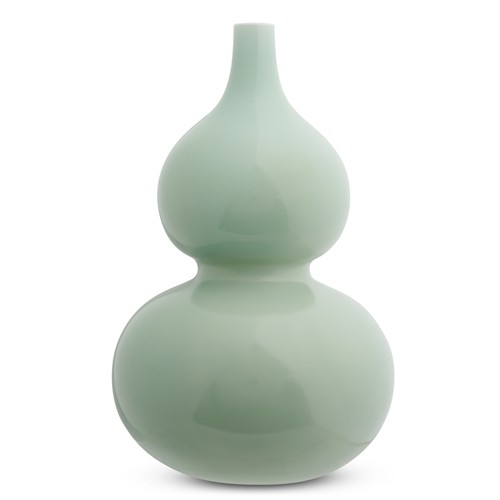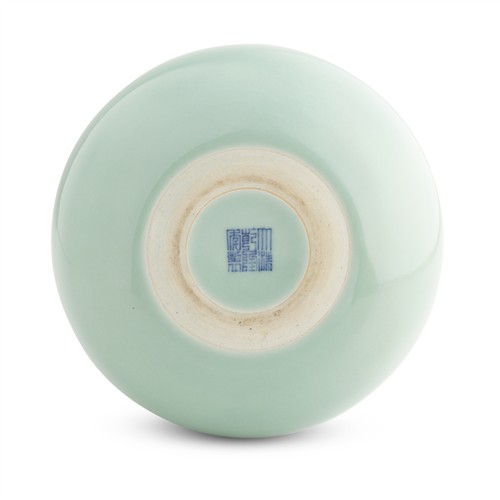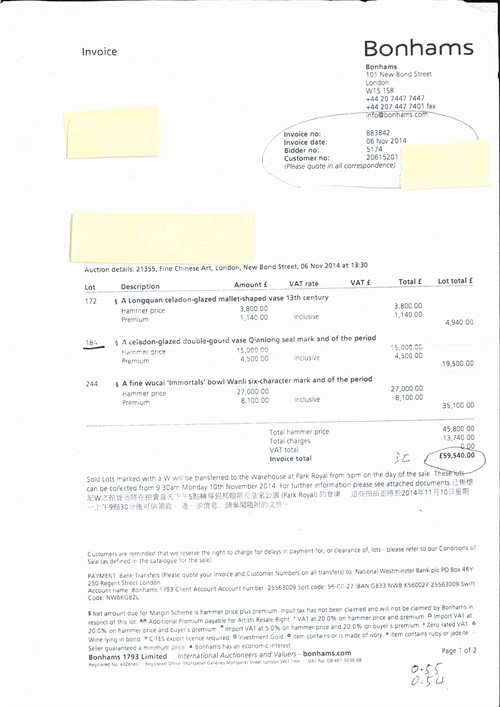Back
A RARE CHINESE CELADON-GLAZED DOUBLE-GOURD VASE, QIANLONG SIX-CHARACTER SEAL MARK IN UNDERGLAZE BLUE AND OF THE PERIOD (1735-1796)
The vase is finely potted with a compressed globular lower bulb rising from a countersunk base to a slightly smaller upper bulb, surmounted by a slender, elongated neck with narrow mouth. The vessel is evenly covered in a soft, translucent celadon glaze of attractive tone.
Double-gourd vases, also known as dajiping ("vase of great fortune"), carry auspicious symbolism, as the gourd is traditionally associated with fertility, abundance, and good fortune.
A closely related vase of the same size was included in the Exhibition of Qing Imperial Porcelain of the Kangxi, Yongzheng, Qianlong Reigns, The Chinese University of Hong Kong, 1995, no. 69. Further comparable examples are published in Chinese Porcelain: The S.C. Ko Tianminlou Collection, vol. I, Hong Kong, 1987, pl. 106; and in Qing Imperial Monochromes: The Zande Lou Collection, Hong Kong, 2005, p. 118, no. 42. A similar vase, preserved with its original small cover, from the Jingguantang Collection, was sold at Christie's Hong Kong, 3 November 1996, lot 571, and again 28 October 2002, lot 723. Additional examples were sold at Christie's Hong Kong, 31 May 2010, lot 2012; Christie's New York, The Gordon Collection, 24 March 2011, lot 1135; and Christie's Hong Kong, 28 May 2014, lot 3308.
The elegant form and soft glaze of the present vase, together with the aforementioned examples, appear to represent a Qing dynasty reinterpretation of earlier Longquan celadon double-gourd vases of the Song dynasty, such as the one illustrated in Mayuyama, Seventy Years, vol. I, Tokyo, 1976, p. 166, no. 484.
清「大清乾隆年製」六字青花篆書款及本朝 豆青釉葫蘆瓶
源流:
英國私人收藏;由前藏家其父親繼承,傳於19世紀末或20世紀初由前藏家之祖母所得。
邦瀚斯倫敦,2014年11月6日,拍品編號184
32.8cm high
Unsold
Lot 49
The vase is finely potted with a compressed globular lower bulb rising from a countersunk base to a slightly smaller upper bulb, surmounted by a slender, elongated neck with narrow mouth. The vessel is evenly covered in a soft, translucent celadon glaze of attractive tone.
Double-gourd vases, also known as dajiping ("vase of great fortune"), carry auspicious symbolism, as the gourd is traditionally associated with fertility, abundance, and good fortune.
A closely related vase of the same size was included in the Exhibition of Qing Imperial Porcelain of the Kangxi, Yongzheng, Qianlong Reigns, The Chinese University of Hong Kong, 1995, no. 69. Further comparable examples are published in Chinese Porcelain: The S.C. Ko Tianminlou Collection, vol. I, Hong Kong, 1987, pl. 106; and in Qing Imperial Monochromes: The Zande Lou Collection, Hong Kong, 2005, p. 118, no. 42. A similar vase, preserved with its original small cover, from the Jingguantang Collection, was sold at Christie's Hong Kong, 3 November 1996, lot 571, and again 28 October 2002, lot 723. Additional examples were sold at Christie's Hong Kong, 31 May 2010, lot 2012; Christie's New York, The Gordon Collection, 24 March 2011, lot 1135; and Christie's Hong Kong, 28 May 2014, lot 3308.
The elegant form and soft glaze of the present vase, together with the aforementioned examples, appear to represent a Qing dynasty reinterpretation of earlier Longquan celadon double-gourd vases of the Song dynasty, such as the one illustrated in Mayuyama, Seventy Years, vol. I, Tokyo, 1976, p. 166, no. 484.
清「大清乾隆年製」六字青花篆書款及本朝 豆青釉葫蘆瓶
源流:
英國私人收藏;由前藏家其父親繼承,傳於19世紀末或20世紀初由前藏家之祖母所得。
邦瀚斯倫敦,2014年11月6日,拍品編號184
32.8cm high
Estimate $35,000 - $55,000
The vase has an area of over-painting to the middle section, it's very hard to identify the condition underneath.
CLICK TO SEE DETAIL PHOTOS OF THE WHOLE AUCTION



